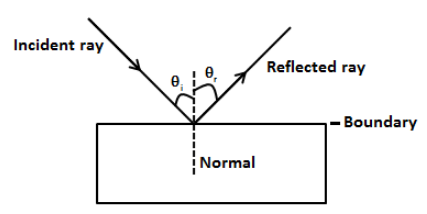
Define angle of reflection?
Answer
555.9k+ views
Hint:When the light ray incident on the certain material, it reflects. The line perpendicular to the boundary between two mediums where the incident ray hit the surface of the other medium is known as normal. The angle made by the reflected ray with the normal defines the angle of reflection.
Complete answer:
We know that when the light ray incident of the material, it either passes through the medium or gets reflected at the boundary. The reflected light is known as reflected ray while the ray which passes through the medium is known as refracted ray.
Now, let’s define the line perpendicular to the boundary between two mediums where the incident ray hit the surface of the other medium as normal. The angle made by the incident ray with the normal is known as incident angle. The angle made by the reflected ray with the normal is known as angle of reflection. The following figure will ease the understanding of angle of incidence and angle of reflection.

When the incident ray falls on the plane surface such as the plane mirror, the angle of reflection equals the angle of incident. If the surface is rough, the angle can be greater or less than the incident angle. The line perpendicular to the surface in the above figure is known as normal, divides the angle of incidence and angle of reflection.
Note: You can also define the angle of refraction as the angle made by the refracted as with the normal. Note that, for reflection to occur, the material on which the light is falling must not necessarily be the opaque. The semi-transparent material also reflects some of the incident light and refracts rest of the incident light.
Complete answer:
We know that when the light ray incident of the material, it either passes through the medium or gets reflected at the boundary. The reflected light is known as reflected ray while the ray which passes through the medium is known as refracted ray.
Now, let’s define the line perpendicular to the boundary between two mediums where the incident ray hit the surface of the other medium as normal. The angle made by the incident ray with the normal is known as incident angle. The angle made by the reflected ray with the normal is known as angle of reflection. The following figure will ease the understanding of angle of incidence and angle of reflection.

When the incident ray falls on the plane surface such as the plane mirror, the angle of reflection equals the angle of incident. If the surface is rough, the angle can be greater or less than the incident angle. The line perpendicular to the surface in the above figure is known as normal, divides the angle of incidence and angle of reflection.
Note: You can also define the angle of refraction as the angle made by the refracted as with the normal. Note that, for reflection to occur, the material on which the light is falling must not necessarily be the opaque. The semi-transparent material also reflects some of the incident light and refracts rest of the incident light.
Recently Updated Pages
Two men on either side of the cliff 90m height observe class 10 maths CBSE

What happens to glucose which enters nephron along class 10 biology CBSE

Cutting of the Chinese melon means A The business and class 10 social science CBSE

Write a dialogue with at least ten utterances between class 10 english CBSE

Show an aquatic food chain using the following organisms class 10 biology CBSE

A circle is inscribed in an equilateral triangle and class 10 maths CBSE

Trending doubts
Why is there a time difference of about 5 hours between class 10 social science CBSE

Write a letter to the principal requesting him to grant class 10 english CBSE

What is the median of the first 10 natural numbers class 10 maths CBSE

The Equation xxx + 2 is Satisfied when x is Equal to Class 10 Maths

Which of the following does not have a fundamental class 10 physics CBSE

State and prove converse of BPT Basic Proportionality class 10 maths CBSE




